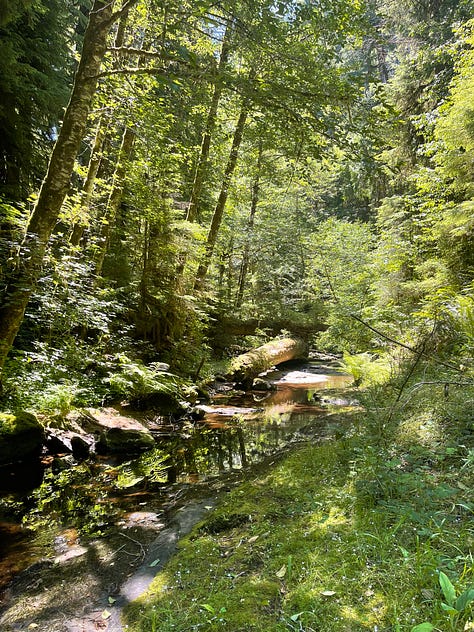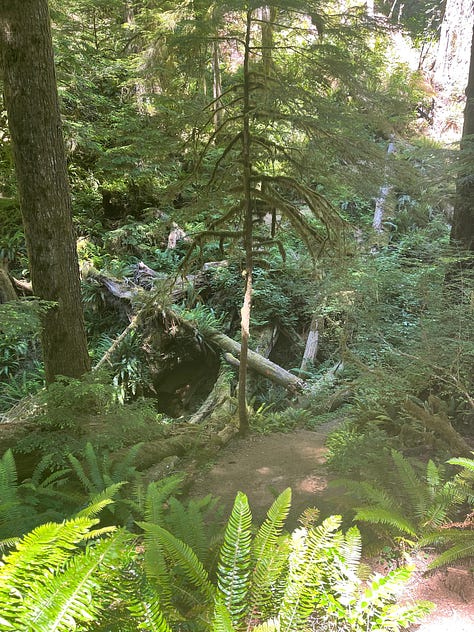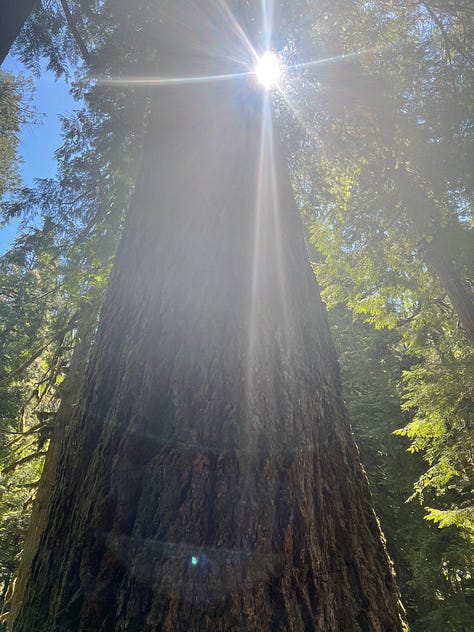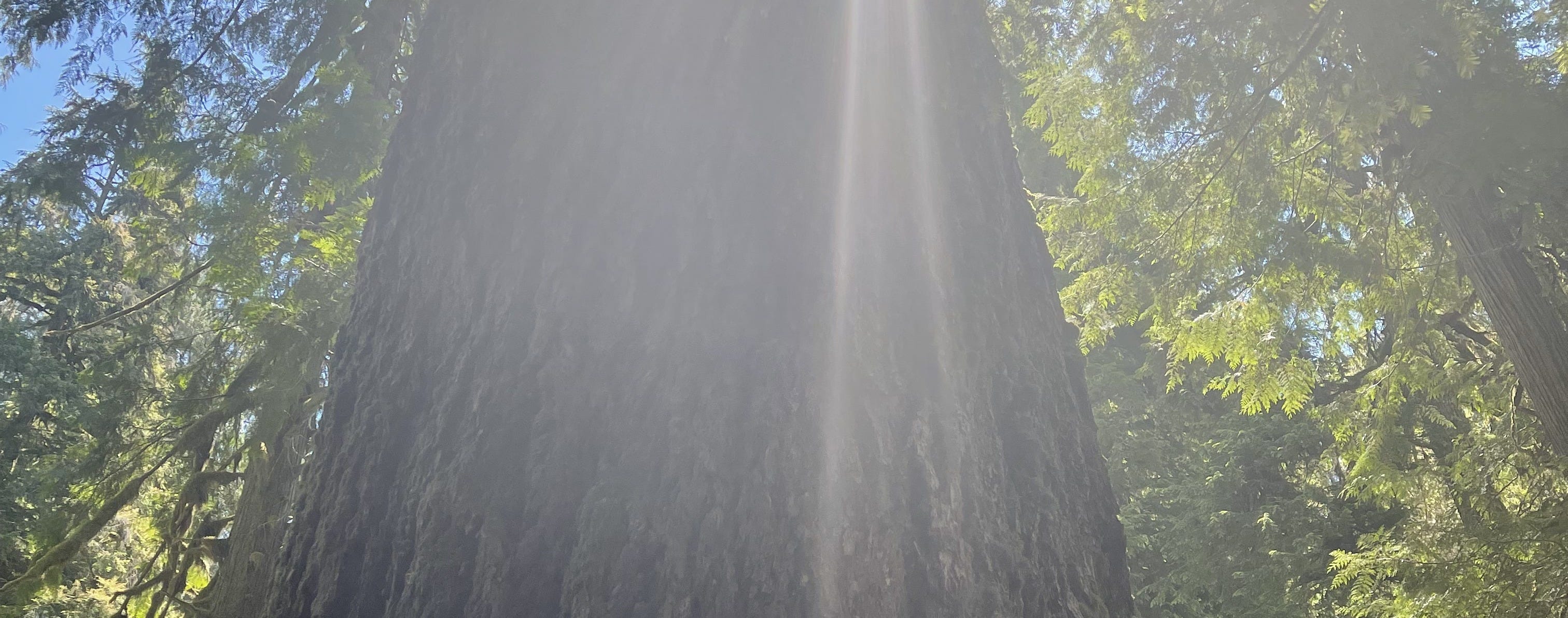The Doerner Fir is on fire
A tribute to the things we value
Being in the presence of something very big and very old is a good way to review your place in the world. Opportunities to be in awe, to feel small but still part of something important, are waiting for us away from our screens, and for the rest of my life I want to make up for the deficit of wonder by getting out into a world too big for me to grasp.
The Doerner Fir mysteriously caught fire several days ago, burning about fifty feet out of its top and cutting it down from its glory as the tallest Douglas Fir tree in the world. As of today we still don’t know how the fire started, but authorities have ruled out lightning. The possibility that this fire was human-caused just baffles me, because why? But people are doing senseless things all the time and you don’t need me to reference a single news article to point this out to you. We do worse things to our fellow humans. Sorry to be a downer, but people can be awful—which I suppose is a form of awe-full but that’s not how I’m using it here. Will I really be surprised if it turns out someone intentionally lit this tree on fire?
I write about the Doerner Fir in my book. It’s a landmark tree in our community, and since we don’t have many positive claims to fame, it’s special. We live about as far west as you can travel in the United States, so “old” architecture is the century farm or a house built in the early 1900s. History here is different from history on the east coast. Trees gets the spotlight, and this one has been around for about 450 years.
In 2021, two friends and I set a goal of one hike per month, and the Doerner Fir made our list in a month when we needed something closer to home. I wrote this about it:
“AllTrails told us it was less than a mile out to the Doerner Fir and back, but we would do some extra hiking to make the drive worth it. As the crow flies, the trail was not that far from where we lived, but the gravel road wound and split off in all directions like an old, frayed cable line, and we took a wrong turn or two. GPS is great but most of the places we hike don’t have cell service, so we had taken some directions from others who’d been before. We had an idea where we were headed but we were surprised by how long it took to drive there.
We hiked the short way in and saw the world’s tallest Douglas Fir tree, and I have pictures but they’re incomprehensible—a massive tree trunk, sun spots at the top of the photo, and no end in sight. It’s impossible to capture 327 feet from the ground. Other photos of the hike into the wooden platform constructed at the base of the tree show massive ferns, moss covered rocks dripping with moisture, and cavernous ravines flowing beneath downed trees. I did not miss the forest for this one giant tree.
It was such a long drive, then such a short hike, to such a tall tree. We stood at its base for maybe two minutes, marveling at all the history this tree had stood for, and then decided to continue on.
Beyond the wooden platform the trail continued, but narrower—more wild and less maintained. We had reached the end of the official trail but a deer path led us around the edge of the mountain, above the creek, and then down to the water’s edge. We discovered more waterfalls, and where the creek rested in places, there were perfect swimming holes. We crossed downed trees over the water, into edens that felt untouched and unseen. Were we the first to see this?
My adventures into the woods always feel primordial. Of course the answer is no, I am not the first one here. I am not the intrepid explorer I dream I am, finding new life at the edge of the world. I am only the center of my world, rounding the earth again, following paths already made. Is there anything I have ever been the first to see? I walk into every wood for my own first time and I breathe air I’ve never breathed; but also: that air has been circulating for ages and the water in it could be the water Jesus was baptized in, filling my lungs, hydrating new cells. Everything is new to me and old to God, and I push the edges of my own known world, even if I am the last to see the Doerner Fir.
We sat on mossy rocks above slippery stone slides formed by millennia of rushing water, each of us a midlife woman thinking of how much fun our young kids would have had in this spot, if only we’d known. Our children were nearly all adults at the time but we are perpetual mothers, continually looking for the wonders of the world to show our children.
It doesn’t seem to matter how much I do for my kids, I could always have done more. Somehow a shift must occur in my thinking: everything is not for the kids now. I can find a beautiful spot and enjoy it just for me. That’s enough; that’s the end, and the means to getting to this place were a long set of years of pouring myself out, like water that will recirculate.
We walked out of eden on almost the same trail we came in on, each of us spreading out parallel to make our own way, to see what we could see. We knew where we’d been and where we were going; no need to follow the exact same path out. Midlife gives so much more freedom.
As we passed the Fir again, the forest merged into an obvious groove in the earth, and the oddity of the wooden platform at its base stood out to me. We’d come from a wild place this time, where it was possible to think for a minute that we were the first inhabitants of the land, and all of a sudden we stepped into a forest less wild, as if walking back had moved us forward in time. I pictured the people who trekked in here with the lumber and tools to build the platform, and the people ranked above them who gave the assignment: there is a very tall tree in the woods and it needs a very sturdy platform at its base, because so many people are going to come and look at it.
Were they builders by trade? Or foresters? Or naturalists volunteering for a summer work party? Why does protecting and promenading one tree outweigh the value of other trees, like the ones felled and sawn for the construction of the platform? Why are some trees—bigger trees, older ones—more valuable than others? These are questions of beauty and justice I can never fully answer, and probably it doesn’t matter. We choose what to protect based on what we value. By choosing one thing, we are not choosing all others.”
Maybe the fire in this tree will remain a mystery. The top was full of dead wood and maybe it just spontaneously erupted in flame. Can that happen? I value mystery and I like this version of the story. We’ll call it “an act of God”, because it’s something we can’t explain yet.





When I read your headline, I gasped. I am more grateful than ever that this chapter is part of your book.
Today I went to Lake Michigan to see the earth meet the sky/ nothing to interfere w the view. It was perfection. Looked like a painting (and I didn’t have my phone.)
I go to the lake on special days and sometimes just because. Today was my little sister‘s birthday. She was born early, lived 7 hours. I never got to see her and I still miss her. I was 11 years old. It was years until I grieved at that loss. It came to the foreground went when my one remaining sibling died in 2005.
I too turn to beauty. It reminds me of the one who created it for me to enjoy and reminds me of his presence.
I always enjoy reading what you have to write